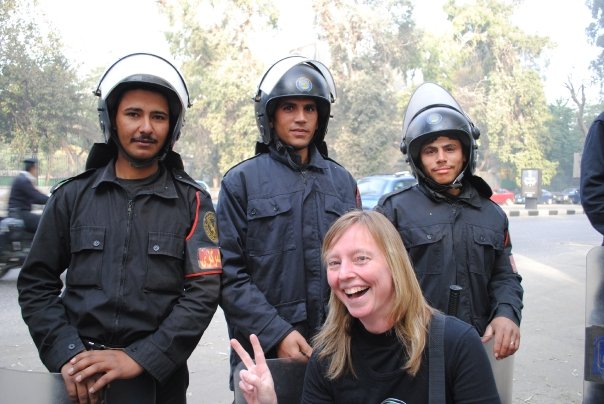(Now back home in London, Ontario with a few bruises and scrapes courtesy of the Egyptian police, frustrated at being blocked from traveling to Gaza but more resolved than ever to build international solidarity with the Palestinian cause).
While their government did everything it could to block our efforts to join our sisters and brothers in Gaza and to spread falsehoods about the nature of the Gaza Freedom March and its participants, the response we got from ordinary Egyptians was overwhelmingly positive.
The police strategy in all cases what to contain our protests and cut us off as much as possible from the Egyptian populace. As often as we were able to get signs in Arabic and/or Palestinian flags where passersby could see them, there were immediate responses of recognition and approval. There are many reports (and some video footage) of the police physically driving away passersby, especially if they tried to photograph or film our demonstrations or bring us supplies. The Egyptian media were keen to cover the Gaza Freedom March and our various demonstrations (they often had to depend on photos taken by GFM participants, since their own photographers were frequently prevented from covering the story), and at least three local reporters were detained while trying to do just that
Let’s not forget: Egyptians live under a police state where gatherings of six or more people are illegal, as is the public display of political signs and banners. So when our ‘flash mob’ took to the streets on December 31 and occupied part of Tahrir Square in downtown Cairo, we knew very well what we were facing – even though the police were nowhere near as brutal with foreign protestors as they would have been with Egyptian nationals. Despite attempts to shut down news of our actions, our protest was quickly broadcast on Al-Jazeera internationally (one of our delegation got a call from family members at home who had seen him on TV) and within Egypt. So many Egyptians saw news reports and began streaming towards the area that the police closed the Sadat metro station as well as the Egyptian Museum (a huge tourist attraction), both in Tahrir Square — their response is a measure of how successful our action was in disrupting Cairo that day.
While we remained behind a police perimeter for several hours (before being forced to move by Police) in “Free Gaza Square”, people in the streets would wave and cheer, and sometimes venture more concrete support. Various people on the outside would try to rush the police lines in an effort to pass us food and water before being pushed back – firmly in the case of internationals, but more harshly if they were Egyptian.
It is worth noting that front-line riot police are all poorly-paid conscripts with no choice but to do as they were ordered regardless of their sympathies, and often on unpaid overtime this week due to the sheer number of protests in and around Cairo. There are many reports of individual riot police smiling, repeating our slogans quietly under their breath or even openly weeping at what their officers were pushing them to do from behind their lines. Much of the overt violence against demonstrators came from the plainclothes security police rather than the uniformed riot cops.
At the French embassy, where marchers occupied the sidewalk for more than five full days after being thwarted in their departure for Gaza, a real rapport developed between the 300 or so French protestors and the police details which surrounded them in a double or triple line. The French delegation included many Arabic speakers who made a point of developing vigorous chants directed at both passersby and security forces (“al-sha3b almasri ma3ana, al-jeysh almasri ma3ana!” – the Egyptian people are with us, the Egyptian army is with us!), at times accompanied by hand-slapping hi-fives down the line of cops. By New Year’s Eve, there was enough of a rapport that the French marchers included their security detachment in their party, sharing food with them (KFC from a local fast-food outlet), and the security officers even relaxed a bit, bringing in benches so that the front-line riot squads could sit rather than stand (as they habitually had to do for a full eight-hour or longer shift). At our rally the next day in front of the Israeli embassy this same detachment was understandably less enthusiastic about pushing back the lines of demonstrators, which meant that the central line of the rally was able to remain more visible on higher ground for longer.
The New Year’s candlelight vigil at Tahrir Square was also the scen of friendlier relations with riot police, as protestors shared sweets with them in a relaxed party atmosphere. Our final outdoor meeting on Friday night (still illegal but now tolerated) had changed the dynamic considerably — though still under the watchful eye of the security forces, they did not attempt to clear us from the square as they would have just days before.
It is to be hoped that Egyptian civil society can make good use of some of the space opened up in the last week. As most GFM participants are leaving or have left Cairo, on Monday a group of Egyptian lawyers and activists were filing suit in the High Court against their government’s plans to build a security wall underneath the border with Gaza that would extend 18 meters below ground and cut off most of the tunnels. They got some of the internationals still present in Cairo to sign onto their legal action, and a public demonstration of support that included both Egyptians and internationals.



